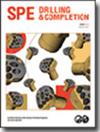Quantifying Global and Random Uncertainties in High Resolution Global Geomagnetic Field Models Used for Directional Drilling
IF 1.2
4区 工程技术
Q3 ENGINEERING, PETROLEUM
引用次数: 3
Abstract
Total field strength, declination, and dip angle of the Earth's magnetic field, in conjunction with gravity, are used by magnetic-survey tools to determine a wellbore's location. Magnetic field values may be obtained from global models that, depending on the model, have a wide range of spatial resolution at the Earth's surface from large scale (3000 km) to small scale (28 km). The magnetic field varies continuously in both time and space, so no model can fully capture the complexity of all sources; hence, there are uncertainties associated with the values provided. The SPE Wellbore Positioning Technical Section/Industry Steering Committee on Wellbore Surveying Accuracy (ISCWSA) published their original measurement-while-drilling (MWD) error model in 2000. Such models and uncertainties define positional error ellipsoids along the wellbore, which assist the driller in achieving their geological target, in addition to aiding collision avoidance. With the recent update to Revision 5 of the ISCWSA error model, we have reassessed the uncertainties associated with our latest high-resolution global magnetic field model. We describe the derivation of location-specific global and random uncertainties for use with predicted geomagnetic values from high-resolution models within magnetic MWD survey-tool-error models. We propose a sophisticated approach to provide realistic values at different locations around the globe; for example, we determine separate errors for regions where the models have high spatial resolution from aeromagnetic data compared to regions where only satellite data are available. The combined uncertainties are freely available via a web service with which the user can also see how they vary with time. The use of the revised uncertainty values in the MWD-error model, in most cases, reduces the positional error ellipsoids and allows better use of the increased accuracy from recent improvements in geomagnetic modeling. This is demonstrated using the new uncertainty values in the MWD-error model for three standard ISCWSA well profiles. A fourth theoretical well offshore Brazil where the vertical magnetic field is weak shows that with drillstring interference correction relying on the more uncertain magnetic dip, the positional error ellipsoids can increase. This is clearly of concern for attaining geological targets and collision avoidance.用于定向钻井的高分辨率全球地磁场模型中全局和随机不确定性的量化
磁测量工具利用地球磁场的总场强、赤纬和倾角以及重力来确定井眼的位置。磁场值可以从全球模式中获得,根据模式的不同,这些模式在地球表面的空间分辨率范围很广,从大尺度(3000公里)到小尺度(28公里)。磁场在时间和空间上都是连续变化的,因此没有一个模型可以完全捕捉所有源的复杂性;因此,存在与所提供的值相关的不确定性。SPE井筒定位技术部/井筒测量精度行业指导委员会(ISCWSA)于2000年发布了原始的随钻测量(MWD)误差模型。这些模型和不确定性定义了沿井筒的位置误差椭球,除了有助于避免碰撞外,还有助于司钻实现其地质目标。随着最近对ISCWSA误差模型修订版5的更新,我们重新评估了与最新的高分辨率全球磁场模型相关的不确定性。我们描述了特定位置的全球和随机不确定性的推导,用于在磁性随钻测量工具误差模型中使用高分辨率模型预测地磁值。我们提出了一种复杂的方法,在全球不同的地点提供现实的价值;例如,与只有卫星数据可用的地区相比,我们确定了模型具有高空间分辨率航磁数据的地区的单独误差。综合的不确定性可以通过网络服务免费获得,用户还可以看到它们是如何随时间变化的。在大多数情况下,在mwd误差模型中使用修正的不确定性值可以减少位置误差椭球,并可以更好地利用最近地磁建模改进所提高的精度。在三个标准ISCWSA井剖面的mwd误差模型中,新的不确定性值证明了这一点。在巴西海上垂直磁场较弱的第四口理论井中,钻柱干扰校正依赖于更不确定的磁倾角,这可能会增加椭球的位置误差。这显然关系到实现地质目标和避免碰撞。
本文章由计算机程序翻译,如有差异,请以英文原文为准。
求助全文
约1分钟内获得全文
求助全文
来源期刊

SPE Drilling & Completion
工程技术-工程:石油
CiteScore
4.20
自引率
7.10%
发文量
29
审稿时长
6-12 weeks
期刊介绍:
Covers horizontal and directional drilling, drilling fluids, bit technology, sand control, perforating, cementing, well control, completions and drilling operations.
 求助内容:
求助内容: 应助结果提醒方式:
应助结果提醒方式:


